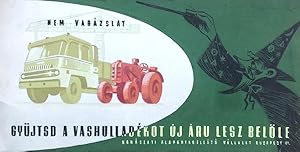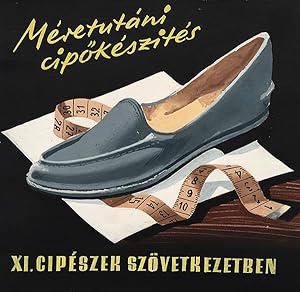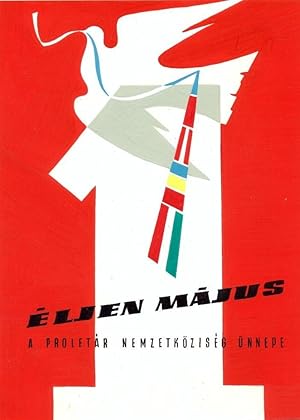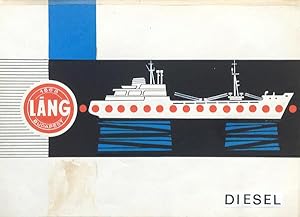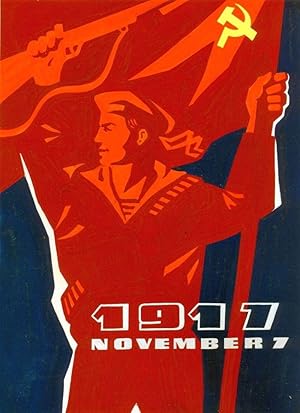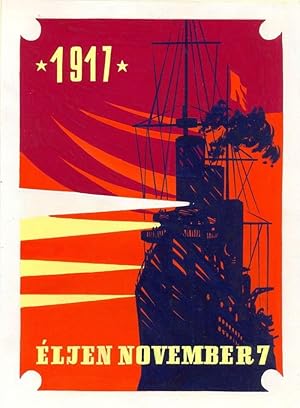altmann bertalan (8 résultats)
Type d'article
- Tous les types d'articles
- Livres
- Magazines & Périodiques
- Bandes dessinées
- Partitions de musique
- Art, Affiches et Gravures (8)
- Photographies
- Cartes
-
Manuscrits &
Papiers anciens
Etat
- Tous
- Neuf
- Ancien ou d'occasion
Reliure
- Toutes
- Couverture rigide
- Couverture souple
Particularités
- Edition originale
- Signé
- Jaquette
- Avec images
- Sans impression à la demande
Pays
Evaluation du vendeur
-
It's not magic - Collect scrap metal - It will become a new commodity
Date d'édition : 1958
Vendeur : Budapest Poster Gallery, Budapest, Hongrie
Art / Affiche / Gravure
Paint on cardboard. Etat : Fine, light wear. Size: Horizontal poster artwork (cca. 30 x 15 cm). It s not magic Collect scrap metal It will become a new commodity is a 1950s vintage Hungarian recycling propaganda painted poster artwork designed by Bertalan Altmann.
-
Custom shoemaking
Date d'édition : 1955
Vendeur : Budapest Poster Gallery, Budapest, Hongrie
Art / Affiche / Gravure
Paint on cardboard. Etat : Near mint. Size: Square (cca. 18 x 18 cm). This original hand painted design was created for a commercial ad advertising custom shoemaking in the 11th Trade Union of Shoemakers The artwork was created by Bertalan Altmann Altmann often created poster designs for state celebrations and anniversaries in the late 1950s He designed modernist compositions during the time when the visual language of the official propaganda was Socialist Realism Although he employed the socialist content it didn t have the typical realist portrayal all the time This artwork is a fine commercial design probably created in the second part of the 1950s After the tough years of the obligatory socialist realist style in the early 1950s in the second part of the decade poster designers could continue to create in the styles they were involved before Modernist tendencies came up and expressive styles were applied again The design here also has quite a modernist look It depicts a light grey moccasin in the centre athwart placed on a white paper with a tape measure loosely thrown on a wooden surface The typograpy appears above and below in yellow The simplified stylized decorative portrayal reminds of the former Art Deco style which was one of the most important tendencies of the interwar period in Hungarian and international poster art The composition bears the characteristics of another former tendency the German Plakatstil Poster Style The so called object posters deriving from the German term Sachplakat consisted of a realistic representation of the advertised product with hardly any other elements and a clean spectacular typography Lucien Bernhardt invented the style in 1905 but it had a huge international impact so on Hungarian poster art too M rton Tuszkay was the first one to introduce the new approach in advertising in the 1910s but the tendency was present for many years later as well This artwork is a fine example for that.
-
Lang Diesel Ship Engines - Lang Budapest 1868
Date d'édition : 1965
Vendeur : Budapest Poster Gallery, Budapest, Hongrie
Art / Affiche / Gravure
Paper, mixed technique. Etat : Fine, light wear. Size: A4 (cca. 21 x 29 cm). Decorative poster maquette for L ng company Size cca 29 5 x 21 5 cm It is a mixed technique of photo and tempera on paper L ng Machine Factory was an important machine firm in Hungary which was founded by L szl Lang in 1868 its Hungarian name is L ng G pgy r The factory started to producing steam engines for factories and ships in the beginnings In 1893 the firm started to produce electric elevators From 1905 the production of steam turbines for alternators began In 1910 the factory extended its product portfolio with boilers and Diesel Engines The large Diesel engines were designed and produced for ships power plants and for factories source wikipedia org This maquette was made for a promotion of the diesel engine In the very middle we can see the photo of the engine itself and the logo of L ng factory The background resemmbles of wavy water and in the front a silhouette of a ship is visible.
-
Long Live the 1st of May - The Celebration of the Proletarian Internationalism
Date d'édition : 1957
Vendeur : Budapest Poster Gallery, Budapest, Hongrie
Art / Affiche / Gravure
Paint on cardboard. Etat : Near mint. Size: Tram poster (cca. 17 x 24 cm). Interesting painted poster artwork created by Bertalan Altmann in 1957 for the socialist celebration of the 1st of May It is the May Day or labour day even today but for some years during the Socialist era in Hungary it was also the celebration of proletarian internationalism A new period started in Hungarian poster art after the 1956 revolution The former R kosi regime was replaced by the K d r system and the new political situation determined the cultural changes as well The former great expansion of political propaganda posters of the 1950s came to an end as the new political leadership realized that political issues should be avoided on streets Along with political propaganda posters commercial posters also disappeared for a while due to the lack of products and independent clients On the other hand the genre of cultural poster had its heyday in the 1960s and 1970s Although political matters could not appear on posters of the time there was an exception big annual political events state celebrations and anniversaries These events could fit in the range of cultural events and posters of them also could function as cultural posters These annual events generated a separated type of cultural poster design and they also gave a hard task to poster designers The topic was the same year by year and the iconography had its own recurrent elements waving flags emblematic state buildings and political symbols appeared in these posters It didn t belong to the fancied duty of poster artists neither but it was a help in case of a constraint of financial matters Compared to the average number of copies of a poster which was about 400 4000 these posters had a high number of copies about 10 30 000 The size of the poster was bigger than average and the quality and thickness of the paper used was also better So this genre was a special type from several aspects This poster artwork is a quite modernist design compared to the fact that the political leadership of the period was fighting against all kinds of modernist visuality The poster artwork was created one year after the end of the absolutism of Socialist Realism in Hungary The style was the compulsory aesthetic norm of the R kosi era but still after 1956 and with the change of the political situation too the aesthetic views of the current political power of Hungary didn t really change A new system was initialized in cultural politcs all kinds of designs were put into three categories prohibited tolerated or promoted Thus new styles could emerge but the old aesthetic views could be propagated easily The posters of annual celebrations could sometimes be exceptions as we can find some examples of them with a more abstract design This poster artwork is a decoratively modern piece with a big white number of 1 in the centre a white figure of a pigeon holding a ribbon in its beak and a line of flags of countries from the former Eastern bloc The background is coloured by the symbolic left wing red The composition is modern and concentrated with the few colours elements and shapes used The visual effect of the different shades used where elements cross contributes to the decorativeness of the design as well The pigeon is a universal symbol of peace the flags of Eastern bloc countries represent the proletarian internationalism celebrated on the 1st of May The use of symbolic elements together with political content makes the poster artwork an obvious propaganda work but compared to the numerous ones of the former R kosi era with the forced socialist realist typical compositions and portrays of political leaders this work is a good example of a skillful and strong visual design Due to the fact that it was created for the socialist celebration of the 1st of May the final poster could function as a cultural poster in the first place Created one year after the revolution of 1956 this piece is also a special relic from the time of changes in Hungary s history.
-
Lang Diesel Ship Engines
Date d'édition : 1958
Vendeur : Budapest Poster Gallery, Budapest, Hongrie
Art / Affiche / Gravure
Paper, mixed technique. Etat : Fine, light wear. Size: Horizontal A4 artwork (cca. 30 x 21 cm). Lang diesel motors is a 1950s vintage Hungarian commercial painted poster artwork designed by Bertalan Altmann Size 29 7 x 21 3 cm Paint and collage.
-
1917 - November 7
Date d'édition : 1957
Vendeur : Budapest Poster Gallery, Budapest, Hongrie
Art / Affiche / Gravure
Paint on cardboard. Etat : Mint. Size: Tram poster (cca. 17 x 24 cm). Colourful painted poster artwork from the end of the 1950s created by Bertalan Altmann to remember the October Revolution of Russia in 1917 A new period started in Hungarian poster art after the 1956 revolution The former R kosi regime was replaced by the K d r system and the new political situation determined the cultural changes as well The former great expansion of political propaganda posters of the 1950s came to an end as the new political leadership realized that political issues should be avoided on streets Along with political propaganda posters commercial posters also disappeared for a while due to the lack of products and independent clients On the other hand the genre of cultural poster had its heyday in the 1960s and 1970s Although political matters could not appear on posters of the time there was an exception big annual political events state celebrations and anniversaries These events could fit in the range of cultural events and posters of them also could function as cultural posters These annual events generated a separated type of cultural poster design and they also gave a hard task to poster designers The topic was the same year by year and the iconography had its own recurrent elements waving flags emblematic state buildings and political symbols appeared in these posters It didn t belong to the fancied duty of poster artists neither but it was a help in case of a constraint of financial matters Compared to the average number of copies of a poster which was about 400 4000 these posters had a high number of copies about 10 30 000 The size of the poster was bigger than average and the quality and thickness of the paper used was also better So this genre was a special type from several aspects Bertalan Altmann often created poster artworks for state celebrations and anniversaries This work was created for the anniversary of the 1917 Russian revolution which was celebrated in every country of the Soviet Union during the Socialist period The celebration was held on the 7th of November but the original revolution was in October accourding to the calendar Russia used in the period As the event was forced to be an international celebration in the Eastern bloc we can find numerous posters in the subject Altmann has another piece of it in our collection in similar colours This poster artwork is an interesting and concentrated design depicting a typical character of socialist iconography a working class man In front of a blue background he is captured in dark red and strident orange holding a gun and a flag with sickle and hammer the symbol of the ruling political system of the era The working class man looks powerful and determined as he is looking back probably from the front of the crowd of a procession He absolutely appears as the hero of the Socialism The strong contrast pictured on the figure of the two warm colurs makes the image a bit more expressive and modern design and the use of few colours and elements also contributes to a concentrated composition Although this work was created as a cultural poster artwork the propagandistic character is obvious Still it is a more colourful and decorative design than the typical socialist realist propaganda posters of the earlier years.
-
1917 - Long Live November 7
Date d'édition : 1957
Vendeur : Budapest Poster Gallery, Budapest, Hongrie
Art / Affiche / Gravure
Paint on cardboard. Etat : Mint. Size: Tram poster (cca. 17 x 24 cm). Very decorative and modern painted poster artwork from the end of the 1950s It was created by Bertalan Altmann for remembering the October Revolution of Russia in 1917 A new period started in Hungarian poster art after the 1956 revolution The former R kosi regime was replaced by the K d r system and the new political situation determined the cultural changes as well The former great expansion of political propaganda posters of the 1950s came to an end as the new political leadership realized that political issues should be avoided on streets Along with political propaganda posters commercial posters also disappeared for a while due to the lack of products and independent clients On the other hand the genre of cultural poster had its heyday in the 1960s and 1970s Although political matters could not appear on posters of the time there was an exception big annual political events state celebrations and anniversaries These events could fit in the range of cultural events and posters of them also could function as cultural posters These annual events generated a separated type of cultural poster design and they also gave a hard task to poster designers The topic was the same year by year and the iconography had its own recurrent elements waving flags emblematic state buildings and political symbols appeared in these posters It didn t belong to the fancied duty of poster artists neither but it was a help in case of a constraint of financial matters Compared to the average number of copies of a poster which was about 400 4000 these posters had a high number of copies about 10 30 000 The size of the poster was bigger than average and the quality and thickness of the paper used was also better So this genre was a special type from several aspects Bertalan Altmann often created poster artworks for state celebrations and anniversaries This work was created for the anniversary of the 1917 Russian revolution which was celebrated in every country of the Soviet Union during the Socialist period The celebration was held on the 7th of November but the original revolution was in October accourding to the calendar Russia used in the period As the event was forced to be an international celebration in the Eastern bloc we can find numerous posters in the subject Altmann has another piece of it in our collection in similar colours This poster artwork is a quite modernist design compared to the fact that the political leadership of the period was fighting against all kinds of modernist visuality The poster artwork was created one year after the end of the absolutism of Socialist Realism in Hungary The style was the compulsory aesthetic norm of the R kosi era but still after 1956 and with the change of the political situation too the aesthetic views of the current political power of Hungary didn t really change A new system was initialized in cultural politcs all kinds of designs were put into three categories prohibited tolerated or promoted Thus new styles could emerge but the old aesthetic views could be propagated easily The posters of annual celebrations could sometimes be exceptions as we can find some examples of them with a more modern design This poster artwork is a decoratively modern piece with the use of a few strident colours and expressive portrayal The central element of the composition is the Aurora cruiser which was one of the three Pallada class warships of Russia and it also became one of the symbols of the October Revolution of Russia from 1917 as one of the first incidents of it took place on it During World War I Aurora operated in the Baltic Sea performing patrols and shore bombardment tasks In 1915 her armament was changed to fourteen 152 mm 6 in guns At the end of 1916 she was moved to Petrograd the renamed St Petersburg for a major repair The city was brimming with revolutionary ferment and part of her crew joined the 1917 February Revolution A revolutionary committee was created on the.
-
Long Live Constitution Day - August 20
Date d'édition : 1956
Vendeur : Budapest Poster Gallery, Budapest, Hongrie
Art / Affiche / Gravure
Paint on cardboard. Etat : Near mint. Size: Tram poster (cca. 24 x 17 cm). Impressive painted poster artwork from the year of 1956 created by Bertalan Altmann It promotes the former national celebration of the constitution which was held on the 20th of August A new period started in Hungarian poster art after the 1956 revolution The former R kosi regime was replaced by the K d r system and the new political situation determined the cultural changes as well The former great expansion of political propaganda posters of the 1950s came to an end as the new political leadership realized that political issues should be avoided on streets Along with political propaganda posters commercial posters also disappeared for a while due to the lack of products and independent clients On the other hand the genre of cultural poster had its heyday in the 1960s and 1970s Although political matters could not appear on posters of the time there was an exception big annual political events state celebrations and anniversaries These events could fit in the range of cultural events and posters of them also could function as cultural posters These annual events generated a separated type of cultural poster design and they also gave a hard task to poster designers The topic was the same year by year and the iconography had its own recurrent elements waving flags emblematic state buildings and political symbols appeared in these posters It didn t belong to the fancied duty of poster artists neither but it was a help in case of a constraint of financial matters Compared to the average number of copies of a poster which was about 400 4000 these posters had a high number of copies about 10 30 000 The size of the poster was bigger than average and the quality and thickness of the paper used was also better So this genre was a special type from several aspects This poster artwork is a decoratively simple and concentrated piece with the national colours in the background and the dome of the Hungarian Parliament in green in the foreground The Hungarian Parliament dates back to the end of the 19th century There was a public tender in 1881 to find the perfect architectural design and Imre Steindl one of the greatest Hungarian architects of his time was the winner with his plan The final edifice was built until 1905 and it became the third largest Parliament building in the world and the secong largest one in Europe The building is located in Budapest the capital city of Hungary along the river Danube Because of its location it also became a symbol of Budapest just as the British Parliament became symbol of London The dome of the Hungarian Parliament is the centric element of the building and one of the main spectacles of Budapest too It s characteristic design is depicted in an expressive way on the poster artwork The political symbol of the red star which was put on the top of the institution during the Socialist era also had to be captured on the poster artwork This work was created for the 20th of August which was originally and is nowadays the national and state celebration of Hungary It is also the anniversary of the canonization of the first Hungarian king I Stephen but during the Socialist era between 1949 and 1989 these were replaced by the anniversary of the new constitution that the first political leadership of the period created Although the poster artwork was created for propaganda reasons it could fit into the range of cultural posters too What s more due to the stressed presentation of the emblematic building of the Hungarian Parliament and of course with an other title the final poster could also have functioned as a tourism poster of its time.


